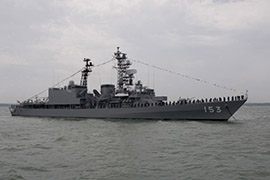Asagiri-class destroyer

JS Yūgiri anchored in the Solent
|
|
| Class overview | |
|---|---|
| Builders: | |
| Operators: | JMSDF |
| Preceded by: | Hatsuyuki-class destroyer |
| Succeeded by: | Murasame-class destroyer |
| Built: | 1986–1989 |
| In commission: | 1986– |
| Completed: | 8 |
| Active: | 8 |
| General characteristics | |
| Displacement: | 3,500 tons standard, 4,900 tons hull load |
| Length: | 137 m (449 ft 6 in) |
| Beam: | 14.6 m (47 ft 11 in) |
| Draft: | 4.5 m (14 ft 9 in) |
| Depth: | 8.8 m (28 ft 10 in) |
| Propulsion: | 4 gas turbines 54,000 shaft horsepower |
| Speed: | 30 knots (56 km/h) |
| Range: | 8,030 nmi (14,870 km) at 14 kn (26 km/h) |
| Complement: | 220 |
| Sensors and processing systems: |
|
| Electronic warfare & decoys: |
|
| Armament: |
|
| Aircraft carried: | 1 × SH-60J(K) anti-submarine helicopter |
The Asagiri-class destroyer was built during the 1980s for service with the Japanese Maritime Self Defense Force.
This class of general purpose destroyer is an extended version of its predecessor Hatsuyuki-class destroyers, and is mainly tasked with ASW and ASUW. The Asagiri-class vessels feature several enhancements and/or improvements over the Hatusyuki class, such as:
Asagiri, Yūgiri, and Amagiri were named after World War II destroyers. Amagiri's World War II namesake rammed and sank PT-109.
The Yamagiri and Asagiri have been converted into training vessels.
JDS Asagiri (DD-151)
JDS Yūgiri (DD-153)
JDS Amagiri (DD-154)
JDS Sawagiri (DD-157)
JDS Asagiri (TV-3516)
JDS Umigiri (DD-158)
The hangar deck of JDS Umigiri (DD-158)
JDS Umigiri (DD-158)
...
Wikipedia
